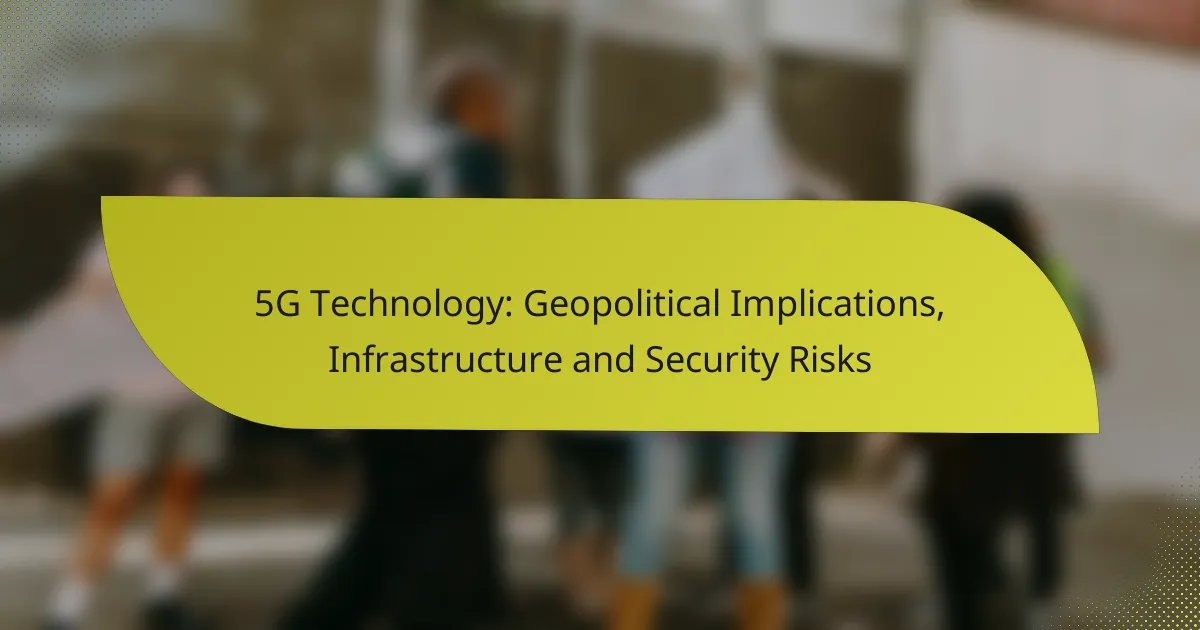The advent of 5G technology carries profound geopolitical implications, reshaping global power dynamics and influencing national security. As countries strive to establish advanced 5G networks, they face not only the challenge of enhancing economic competitiveness but also the pressing need to address the security vulnerabilities that accompany this transformative infrastructure. With the potential for increased cyber threats, the race for 5G supremacy highlights the delicate balance between innovation and security in the modern world.
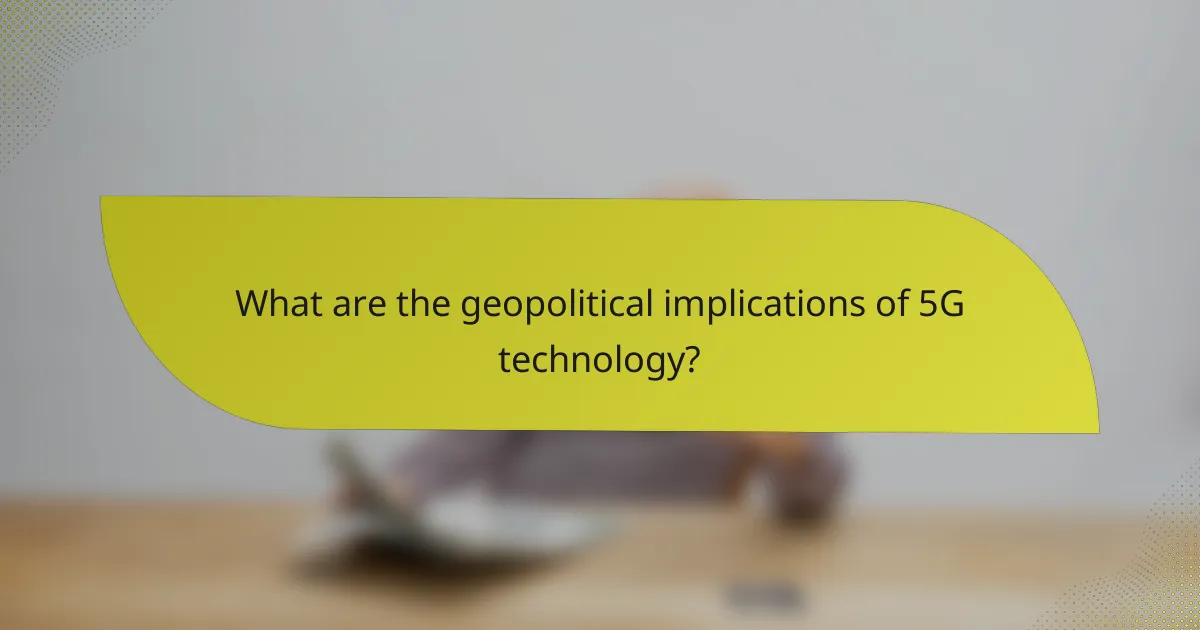
What are the geopolitical implications of 5G technology?
The geopolitical implications of 5G technology are significant, affecting global power structures, international trade, and national security. As nations race to develop and deploy 5G networks, the technology becomes a critical asset that can enhance economic competitiveness and influence global alliances.
Impact on global power dynamics
5G technology is reshaping global power dynamics by enabling faster communication and data transfer, which can enhance a nation’s technological capabilities. Countries with advanced 5G infrastructure can gain a competitive edge in various sectors, including telecommunications, manufacturing, and artificial intelligence.
This shift can lead to a reconfiguration of alliances, as nations may choose partners based on technological capabilities and security assurances. The race for 5G supremacy can exacerbate tensions between major powers, particularly between the United States and China.
Influence on international trade
The rollout of 5G technology is poised to transform international trade by facilitating more efficient supply chains and logistics. Enhanced connectivity allows for real-time tracking of goods, reducing delays and costs associated with transportation.
Countries that adopt 5G can attract foreign investment and boost exports by improving their technological infrastructure. However, trade policies may need to adapt to address the implications of technology transfer and data privacy concerns associated with 5G networks.
National security concerns
National security is a critical concern regarding 5G technology, as the infrastructure can be vulnerable to cyberattacks and espionage. Governments must assess the risks posed by foreign technology providers, particularly those from nations with different security standards.
To mitigate these risks, countries may implement regulations that restrict the use of certain foreign equipment in their 5G networks. Establishing robust cybersecurity measures and fostering domestic technology development are essential steps for ensuring national security.
Case studies: USA vs China
The competition between the USA and China in the 5G arena exemplifies the geopolitical stakes involved. The United States has taken a strong stance against Chinese companies like Huawei, citing security risks and potential espionage as key concerns.
In contrast, China has aggressively pursued 5G deployment, positioning itself as a leader in telecommunications technology. This rivalry not only affects bilateral relations but also influences global standards and practices in 5G technology, impacting other nations’ decisions on infrastructure development and partnerships.
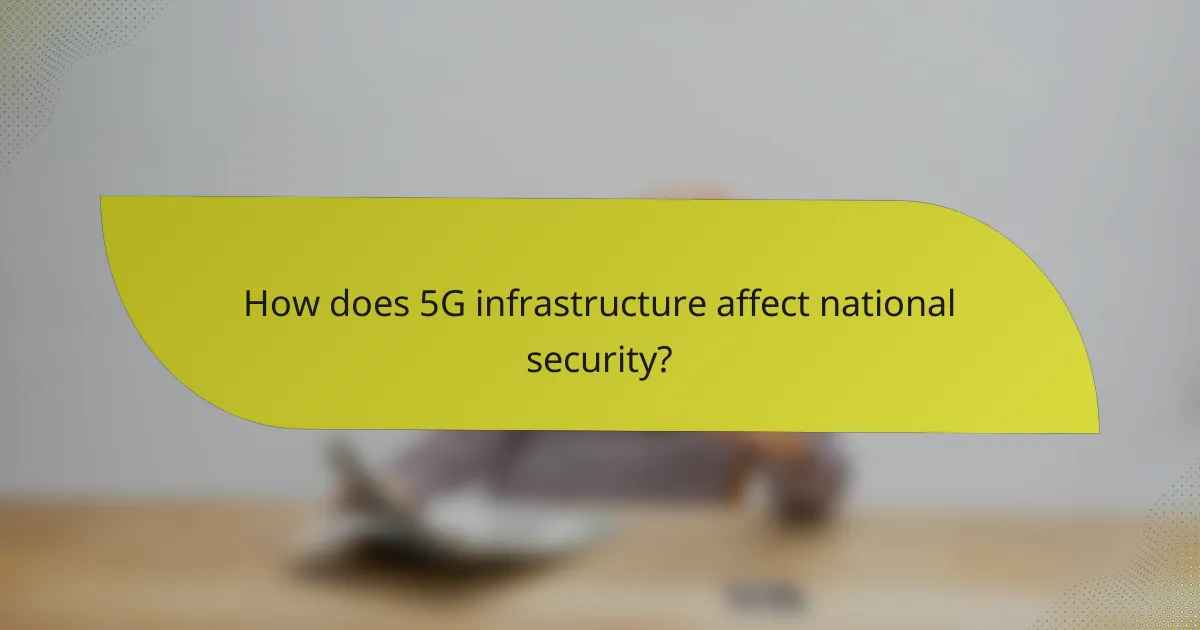
How does 5G infrastructure affect national security?
5G infrastructure significantly impacts national security by introducing new vulnerabilities and increasing the potential for cyber threats. The advanced capabilities of 5G networks can enhance communication and data transfer, but they also create opportunities for malicious actors to exploit weaknesses in the system.
Vulnerabilities in network architecture
The architecture of 5G networks is inherently more complex than previous generations, which can lead to various vulnerabilities. For instance, the reliance on software-defined networking (SDN) and network functions virtualization (NFV) can create points of failure that attackers might exploit. Additionally, the integration of numerous devices increases the attack surface, making it challenging to secure every endpoint.
Moreover, the use of shared infrastructure among different service providers can lead to security gaps if proper protocols are not enforced. Ensuring that all components of the network adhere to stringent security standards is crucial to mitigate these risks.
Risks of foreign surveillance
5G technology raises concerns about foreign surveillance due to the involvement of global vendors in network deployment. Countries may fear that equipment from certain manufacturers could contain backdoors, allowing foreign governments to intercept sensitive communications. This risk is particularly pronounced in nations with strained relations with specific countries.
To address these concerns, many governments are scrutinizing the supply chain of 5G technology and considering bans on equipment from certain foreign companies. This scrutiny aims to protect national interests and maintain the integrity of critical infrastructure.
Mitigation strategies for governments
Governments can adopt several strategies to mitigate the security risks associated with 5G infrastructure. First, implementing strict regulations on the procurement of telecommunications equipment can help ensure that only trusted vendors are used. This includes conducting thorough security assessments and requiring compliance with established cybersecurity frameworks.
Additionally, investing in cybersecurity training for personnel involved in managing 5G networks is essential. Regular audits and updates to security protocols can further enhance resilience against potential threats. Collaboration with international partners to share intelligence on emerging threats can also strengthen national security in the context of 5G technology.
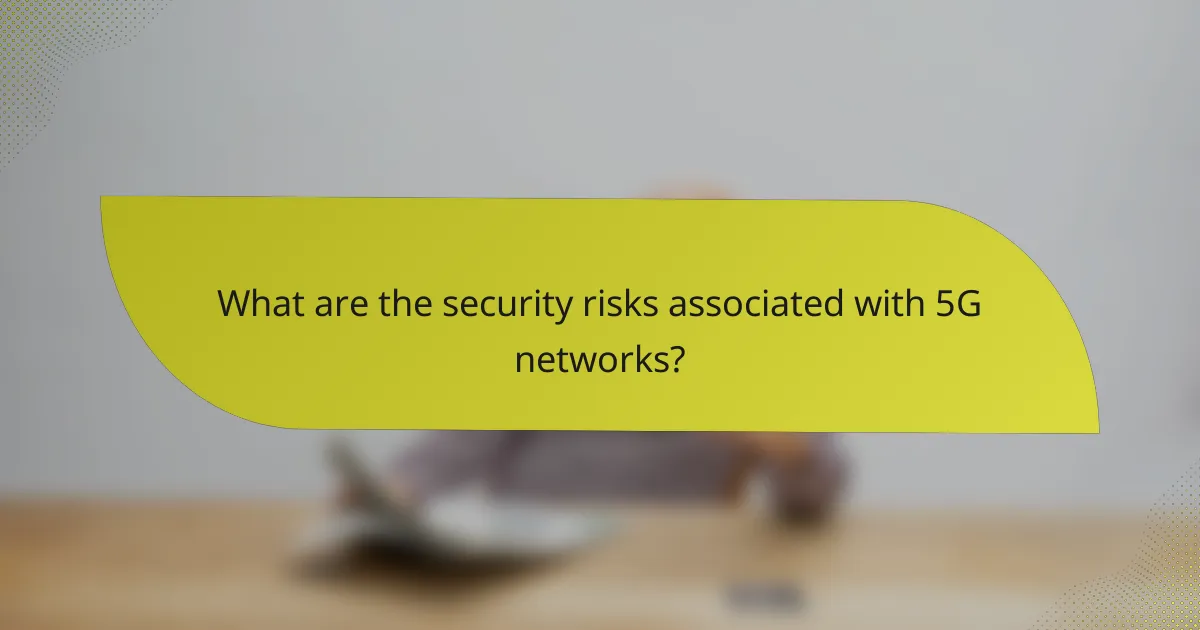
What are the security risks associated with 5G networks?
The security risks associated with 5G networks include vulnerabilities that can be exploited by malicious actors, leading to potential data breaches and increased cyber threats. As 5G technology expands, the complexity of its infrastructure creates more opportunities for attacks, necessitating robust security measures.
Increased attack surfaces
5G networks introduce a wider array of devices and connections, significantly increasing the attack surfaces that cybercriminals can target. The integration of Internet of Things (IoT) devices, which often have weaker security protocols, further complicates the landscape. This expanded connectivity means that a single compromised device can lead to broader network vulnerabilities.
Organizations must prioritize securing all endpoints, including IoT devices, to mitigate these risks. Regular updates and patches are essential to protect against known vulnerabilities.
Potential for data breaches
The potential for data breaches in 5G networks is heightened due to the vast amount of data transmitted and the speed at which it travels. Sensitive information, such as personal data and financial transactions, can be intercepted if proper encryption and security measures are not implemented. The reliance on cloud services for data storage also raises concerns about unauthorized access.
To reduce the risk of data breaches, organizations should employ end-to-end encryption and conduct regular security audits. Implementing strict access controls can further safeguard sensitive information from unauthorized users.
Examples of 5G-related cyber incidents
Several notable cyber incidents have highlighted the vulnerabilities within 5G networks. For instance, researchers have demonstrated how attackers could exploit weaknesses in network slicing, a feature that allows operators to create multiple virtual networks on a single physical infrastructure. This could lead to unauthorized access to critical services.
Another example includes attacks on IoT devices connected to 5G networks, where hackers gained control over smart home systems, leading to privacy violations and potential physical security threats. These incidents underscore the importance of proactive security measures in the deployment of 5G technology.
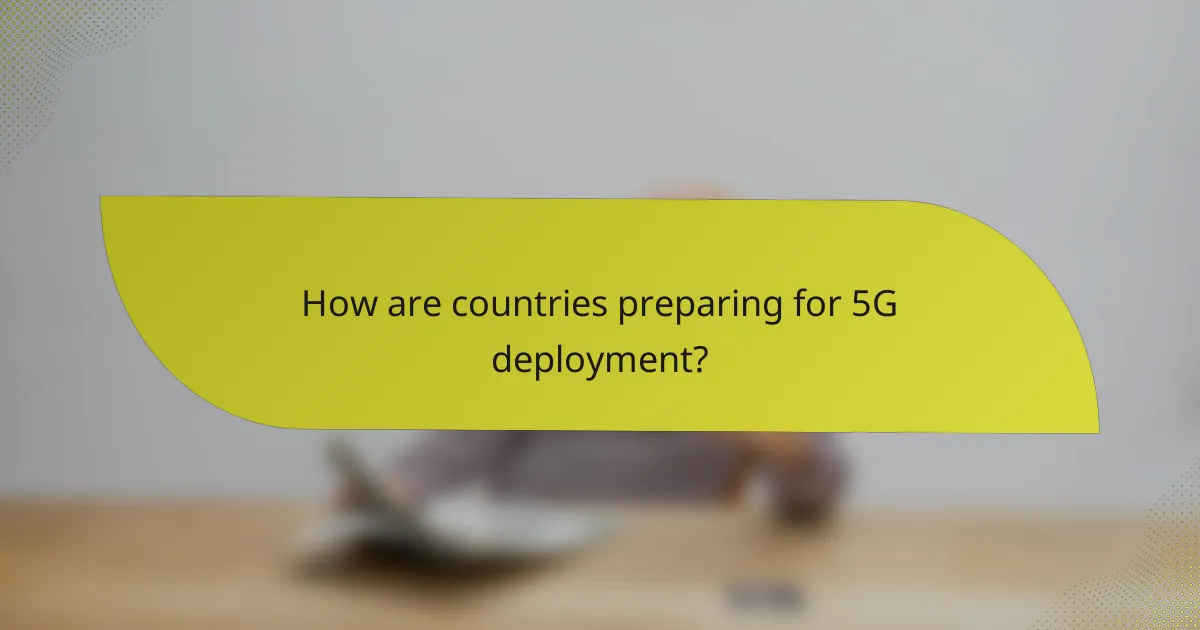
How are countries preparing for 5G deployment?
Countries are actively preparing for 5G deployment through various strategies that encompass regulatory frameworks, investment initiatives, and collaborations between public and private sectors. These preparations aim to enhance connectivity, support economic growth, and address security concerns associated with the new technology.
Regulatory frameworks in Europe
European countries are establishing comprehensive regulatory frameworks to facilitate 5G deployment. The European Commission has set ambitious targets, aiming for widespread 5G coverage by 2025, which includes harmonizing spectrum allocation and ensuring that member states adhere to common standards.
National regulators are also working on licensing frequencies and addressing issues related to infrastructure sharing. For instance, countries like Germany and France are prioritizing the auction of spectrum bands to encourage competition and innovation in the telecommunications sector.
Investment strategies in Asia
Asian nations are heavily investing in 5G infrastructure to maintain technological leadership. Countries such as China and South Korea are leading the charge, with substantial government funding and private sector involvement driving rapid deployment. Investment amounts can reach billions of USD, focusing on building robust networks and enhancing research and development.
In addition to direct investments, Asian governments are incentivizing private companies to participate in 5G projects through subsidies and tax breaks. This collaborative approach aims to accelerate the rollout of 5G services while ensuring that local businesses can compete effectively in the global market.
Public-private partnerships in the USA
The United States is leveraging public-private partnerships to advance its 5G deployment efforts. The Federal Communications Commission (FCC) has initiated programs to streamline the permitting process for new infrastructure, which encourages private companies to invest in building 5G networks.
These partnerships often involve collaboration between federal, state, and local governments with telecommunications firms. By sharing resources and expertise, these entities can address challenges such as infrastructure costs and regulatory hurdles, ultimately speeding up the rollout of 5G technology across the country.
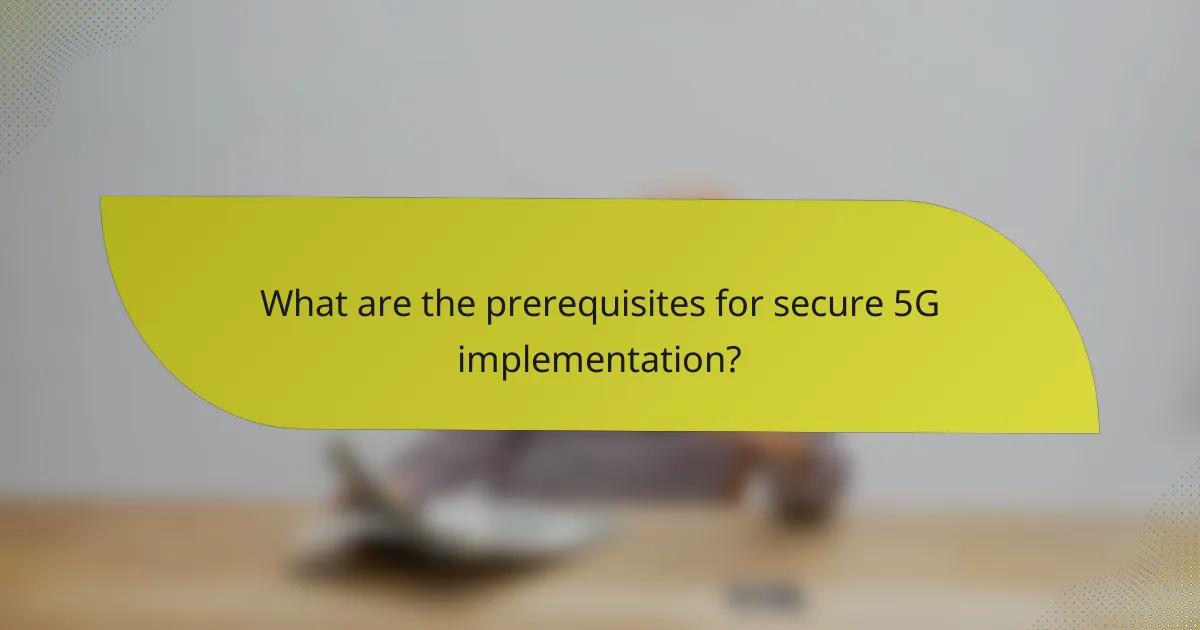
What are the prerequisites for secure 5G implementation?
Secure 5G implementation requires robust technological standards and effective collaboration among various stakeholders. These elements ensure that the infrastructure is resilient against potential security threats while meeting the demands of modern connectivity.
Technological standards and protocols
Establishing clear technological standards and protocols is essential for secure 5G deployment. These standards, such as those set by the International Telecommunication Union (ITU) and the 3rd Generation Partnership Project (3GPP), define the specifications for network architecture, security measures, and interoperability among devices.
Adopting these standards helps mitigate risks associated with vulnerabilities in the network. For instance, implementing end-to-end encryption and secure authentication protocols can significantly reduce the likelihood of data breaches and unauthorized access.
Collaboration among stakeholders
Collaboration among stakeholders, including governments, telecom operators, and technology providers, is critical for a secure 5G ecosystem. This partnership facilitates information sharing about potential threats and best practices for security measures.
Regular joint exercises and discussions can enhance preparedness against cyber threats. For example, establishing public-private partnerships can lead to better resource allocation and faster response times in the event of a security incident.
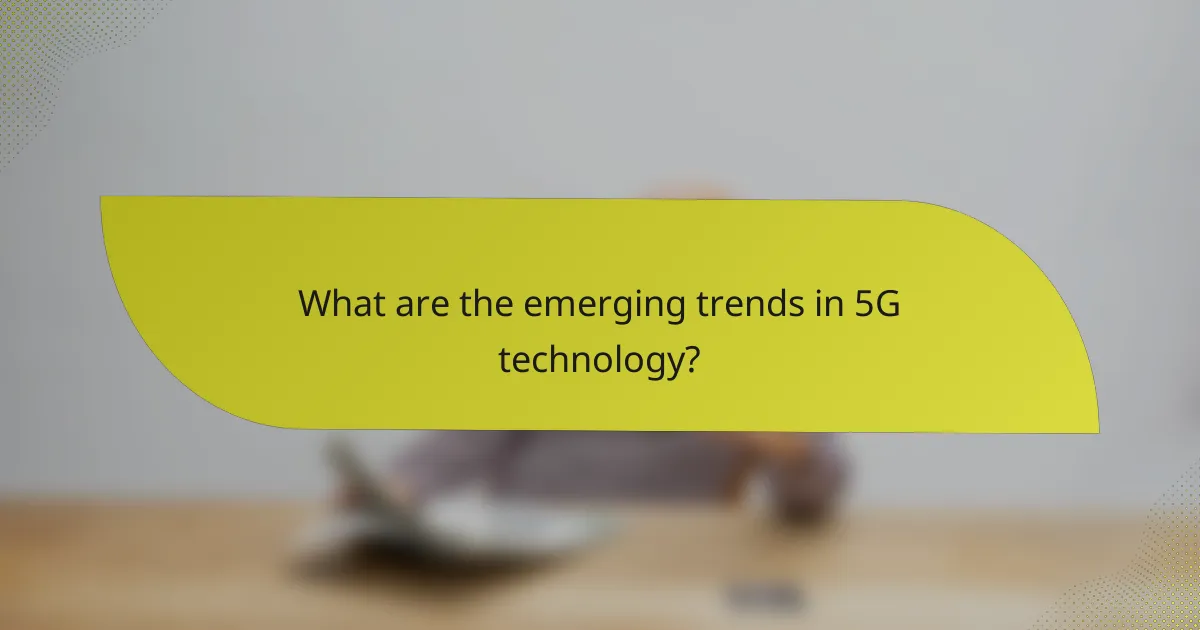
What are the emerging trends in 5G technology?
Emerging trends in 5G technology include enhanced connectivity, increased data speeds, and the integration of advanced technologies like IoT and AI. These developments are shaping industries and creating new opportunities while also raising security concerns.
Integration with IoT and AI
The integration of 5G with Internet of Things (IoT) and Artificial Intelligence (AI) is transforming how devices communicate and process data. With 5G’s low latency and high bandwidth, IoT devices can transmit data in real-time, enabling smarter applications in sectors like healthcare, manufacturing, and smart cities.
For example, in smart cities, 5G can support thousands of connected devices, allowing for efficient traffic management and improved public safety. Companies should consider investing in 5G-compatible IoT solutions to leverage these advancements effectively.
Development of 6G technology
While 5G is still being rolled out globally, research into 6G technology is already underway, aiming for even faster speeds and more reliable connections. Expected to be commercially available around 2030, 6G will likely enhance mobile broadband and enable new applications, such as holographic communications and advanced virtual reality experiences.
Organizations should stay informed about 6G developments, as early adoption of emerging technologies can provide a competitive edge. Engaging with research initiatives and partnerships in the telecommunications sector may also be beneficial for future-proofing investments.
